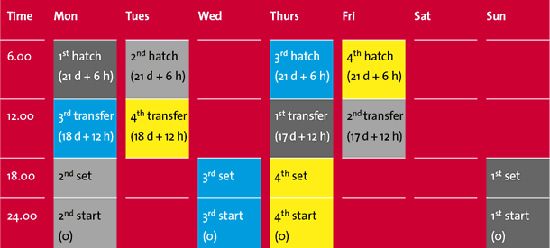



When and How to Transfer Eggs to the Hatcher
Advice on maintaining optimal climatic conditions for eggs of various setting dates and the newly emerging chicks from Gerd de Lange of Pas Reform.Traditionally, setting and hatching occurred in the same incubator, with new eggs being set twice weekly. Generally, hatching baskets were situated at the bottom of the incubator, where temperatures were lower. But this system was not successful in terms of maintaining egg hygiene, as the fluff from hatched chicks contaminates unhatched eggs, and the system did not facilitate proper cleaning and disinfection. It was also impossible to create optimal climatic conditions for eggs of various setting dates and the newly emerging chicks at the same time.
 |
Today, it is common practice to place eggs in the setter for the first 18 days, before transferring them to the hatcher for the last three days of incubation. Generally, this occurs between the embryonic ages of 17 days and 12 hours and 18 days and 12 hours, to coincide with the normal working schedule of the hatchery (see table), whereby hatchers are used twice a week.
In this scenario, incubation time is measured from the (assumed) moment the eggs reach optimum internal temperature for embryonic development, and not from the moment the eggs are placed in the muli-stage setter or from the moment the single-stage setter is switched on. Depending on the setting system, heating capacity and initial egg temperature (in relation to the method and duration of preheating) corrections must be made if one wants to express incubation times from machine start-up. For example, in the table, corrector time equaties to six extra hours.
Fluctuations in production planning may dictate transfer either earlier or later than in normal practice.
Transfer to the hatcher can happen as early as 15 days (= 360 hours of incubation), as there is no evidence to suggest that stopping turning after 15 days of incubation in domestic fowl has any deleterious effects on development and hatchability (Deeming, 2002). However, it is our practical experience that transferring to the hatcher at this moment can reduce hatchability by 0.5 to 1.0 per cent.
Transferring to the hatcher should not occur after 19 days (456 hours) of incubation, because disturbing the eggs at this time adversely affects the act of internal pipping.
Advice
- Transfer eggs after 17 days and 12 hours of incubation to the hatcher but not later than 19 days (= 456 hours). Only in exceptional or unavoidable circumstances, should eggs be transferred as early as 15 days (= 360 hours).
- Adjust hatcher climate in relation to the age of embryos, if transfer must occur before the recommended minimum of 17 days and 12 hours. In practice, the set-points of the setter should be followed. However, as there is increased airflow over the eggs once they are positioned horizontally in the hatcher baskets, it may be necessary to increase set-points by, for example, 0.2°F.
- Maximise the time from setter to hatcher to 20 to 30 minutes.
- Maintain a good climate in the transfer room (approximately 25°C and avoid draught).
- Leave the setter switched on as long as there are still eggs inside! Failure to do so will impede the cooling of the eggs, which is likely to produce late mortality due to overheating.
- Empty setter trolleys from top to bottom, to avoid exposure to high temperatures in the topmost trays as a result of rising heat from the embryos in the lower trays.
- Handle the eggs carefully during transfer. Eggs cracked during transfer have reduced hatch potential due to dehydration.
- Make sure the hatcher baskets are dry.
- Fill the warmed hatcher with trolleys according to the manufacturer's recommendations. This is particularly important when the hatcher is not filled to capacity.

December 2011








